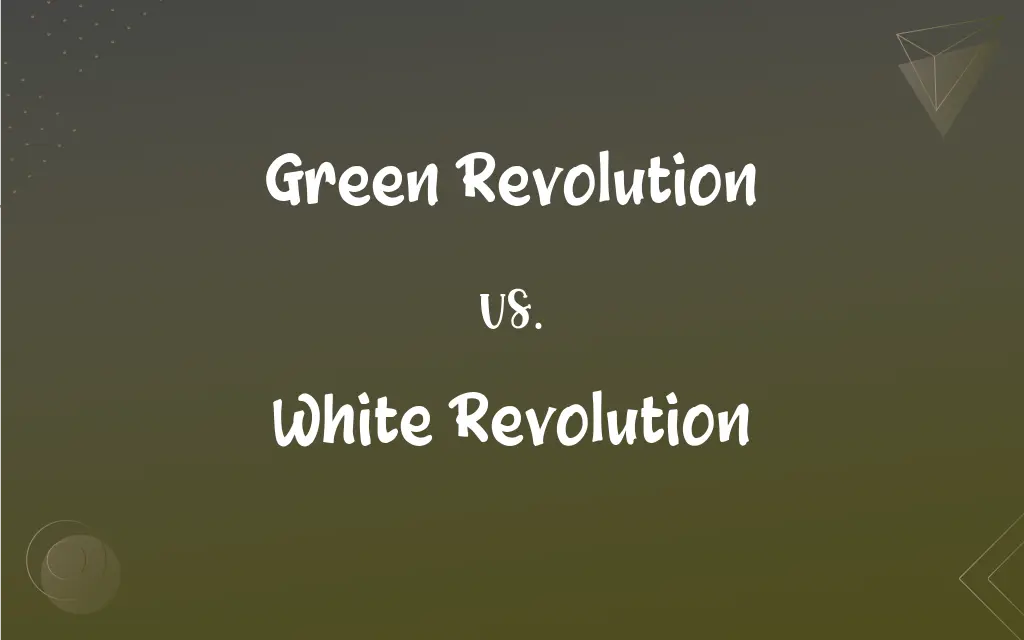Green Revolution vs. White Revolution: What's the Difference?
Edited by Aimie Carlson || By Harlon Moss || Published on February 23, 2024
The Green Revolution refers to increased agricultural production via modernization, while the White Revolution pertains to the rapid growth of the dairy sector.

Key Differences
The Green Revolution involved the development and application of high-yielding crop varieties, enhanced irrigation, and the use of chemical fertilizers and pesticides to increase agricultural productivity. In contrast, the White Revolution focused primarily on milk production, aiming to increase dairy yield and improve rural livelihoods through cooperative milk unions and dairy farming advancements.
Initiated in the 1960s, the Green Revolution significantly increased food grain production, particularly in developing countries, helping to combat hunger and poverty. The White Revolution, started in India in the 1970s, transformed the dairy industry into a high-yielding, organized sector, making India one of the largest milk producers globally.
A key element of the Green Revolution was the introduction of new agricultural technologies, including genetically modified seeds, which led to a substantial increase in crop yields. On the other hand, the White Revolution was characterized by modernizing dairy farming practices, enhancing milk processing, and establishing efficient supply chains.
The Green Revolution was widely credited for preventing famines and boosting economies in agrarian societies, it also faced criticism for causing environmental damage and favoring larger farms. The White Revolution, though successful in augmenting dairy production, had its challenges, including the need for constant innovation to maintain productivity and quality.
The Green Revolution had a global impact, influencing agricultural practices in many countries, whereas the White Revolution was more localized, with its most notable success in India, influencing other nations to adopt similar models in dairy development.
ADVERTISEMENT
Comparison Chart
Focus
Agricultural production
Dairy production
Initiation
1960s
1970s (notably in India)
Key Elements
High-yielding crops, fertilizers
Dairy farming modernization
Global Impact
Widespread, multiple countries
Mostly in India, with global influence
Main Achievements
Increased food grain production
Increased milk production
ADVERTISEMENT
Green Revolution and White Revolution Definitions
Green Revolution
Adoption of intensive agriculture methods.
Irrigation systems improved remarkably during the Green Revolution.
White Revolution
Rapid growth in the dairy sector.
The White Revolution drastically increased milk production in India.
Green Revolution
Use of modern techniques and technologies in farming.
The Green Revolution led to the widespread use of fertilizers.
White Revolution
Movement to enhance dairy yield and quality.
Quality control became a priority during the White Revolution.
Green Revolution
A large-scale agricultural reform for higher yields.
The Green Revolution transformed India's food security landscape.
White Revolution
Establishment of cooperative dairy farms.
Farmers' incomes rose thanks to the White Revolution.
Green Revolution
Introduction of high-yielding varieties of seeds.
Wheat production soared during the Green Revolution.
White Revolution
Modernization of milk production and processing.
The White Revolution introduced advanced dairy technologies.
Green Revolution
A movement to increase global food production.
The Green Revolution helped many countries avoid famine.
White Revolution
Transformation of traditional dairy practices.
The White Revolution led to sustainable dairy farming models.
FAQs
What was the main aim of the Green Revolution?
To increase agricultural productivity and food security.
What were the environmental impacts of the Green Revolution?
It led to soil degradation, water depletion, and pesticide use concerns.
Was the Green Revolution successful worldwide?
It had varying degrees of success, significant in some countries.
Which crops were most impacted by the Green Revolution?
Wheat and rice.
Was the White Revolution confined to India?
It started in India but influenced dairy practices in other countries.
Did the Green Revolution use genetically modified crops?
Yes, it involved high-yielding and sometimes genetically modified varieties.
What triggered the White Revolution?
The need to increase milk production and improve dairy farmers' livelihoods.
How sustainable was the Green Revolution?
Its sustainability is debated due to environmental and social impacts.
What was a key feature of the White Revolution?
The establishment of milk producer cooperatives.
What role did technology play in the White Revolution?
It introduced advanced dairy processing and farming technologies.
Did the Green Revolution affect small-scale farmers?
Yes, but often favored larger, more resource-rich farmers.
How did the Green Revolution change agricultural practices?
It led to more intensive and technology-driven farming.
Can the White Revolution be replicated in other sectors?
Its principles can be adapted to other sectors for similar impact.
How did the White Revolution impact rural economies?
It significantly improved income and employment in rural areas.
Did the White Revolution affect consumer milk prices?
It generally led to more stable and reasonable prices.
How did the White Revolution transform the dairy industry?
Through modernization and cooperative farming models.
How did the Green Revolution impact global food security?
It significantly contributed to reducing hunger in many regions.
Did the White Revolution face any challenges?
Yes, including maintaining quality and adapting to market changes.
What are the lasting impacts of the Green Revolution?
Increased food production, but also environmental and social issues.
What was unique about the White Revolution's approach?
Its focus on cooperative and community-based development.
About Author
Written by
Harlon MossHarlon is a seasoned quality moderator and accomplished content writer for Difference Wiki. An alumnus of the prestigious University of California, he earned his degree in Computer Science. Leveraging his academic background, Harlon brings a meticulous and informed perspective to his work, ensuring content accuracy and excellence.
Edited by
Aimie CarlsonAimie Carlson, holding a master's degree in English literature, is a fervent English language enthusiast. She lends her writing talents to Difference Wiki, a prominent website that specializes in comparisons, offering readers insightful analyses that both captivate and inform.































































